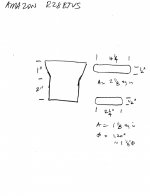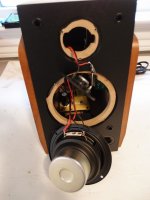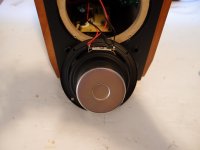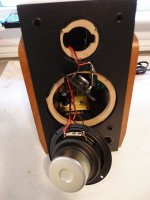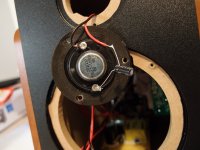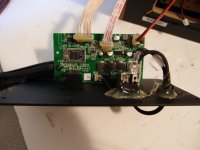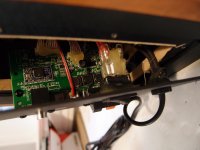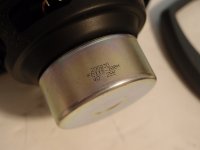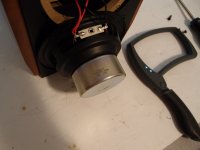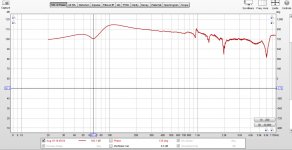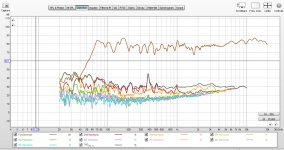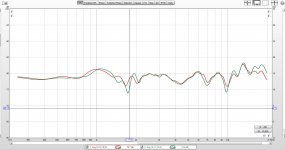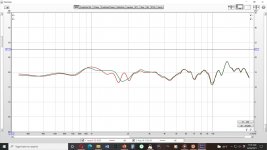I do recommend the TCP-115 over the B4N woofer used in the OS. My Dayton 4 speaker is very simple and others have already modified it to work with the nd20 tweeter.
But Planet10 (Dave) has made an excellent suggestion with the Markaudio Alpair 6M, the current model AFAIK:
Markaudio Alpair-6M Gold 3.5" Fullrange Gen 2
Actually NLA. Get them while they last. A superb midTweeter.
dave
Both these look good as options cabinet and driverwise, but I'm not sure about the port. The Alpair would be drop in with a good fit and no mods other than plugging the tweeter hole and reducing the volume to 3.2L. It appears the 1"dia/2"L port for the bass reflex design is equivalent to the existing port if the existing slot is equivalent to 1.2"D/3"L, but I can't say for sure due to the way the port expands (see diagram). Does this shape affect tuning or is the entry area of the port the driver? The existing port/enclosure do not offer any opportunity for modification.
The Dayton port at 1 1/8"D/6.5"L is just too long, unless there is a way to work around this. Otherwise, it would definitely be a good option.
The Dayton port at 1 1/8"D/6.5"L is just too long, unless there is a way to work around this. Otherwise, it would definitely be a good option.
Attachments
Measuring box tuning.
If you want to go down this rabbit hole of DIY... You will need a way to measure impedance. ARTA LIMP is free to use and just requires a simple jig to get great results.
If you want to go down this rabbit hole of DIY... You will need a way to measure impedance. ARTA LIMP is free to use and just requires a simple jig to get great results.
reducing the volume to 3.2L.
the Mar-Ken for these is 3.6 litre, the alignment for 5 litre is not too compromised, 4 litre a bit better.
How well braced are they? Pictures inside?
dave
They are small and have no bracing internally. 1/2" mdf with the faux wood side panels.
Attachments
Last edited:
Both these look good as options cabinet and driverwise, but I'm not sure about the port. The Alpair would be drop in with a good fit and no mods other than plugging the tweeter hole and reducing the volume to 3.2L. It appears the 1"dia/2"L port for the bass reflex design is equivalent to the existing port if the existing slot is equivalent to 1.2"D/3"L, but I can't say for sure due to the way the port expands (see diagram). Does this shape affect tuning or is the entry area of the port the driver? The existing port/enclosure do not offer any opportunity for modification.
The Dayton port at 1 1/8"D/6.5"L is just too long, unless there is a way to work around this. Otherwise, it would definitely be a good option.
The port changing size may change how it behaves. I tuned the TCP-115 to the low fifties IIRC. A smaller port will be more apt to cuff at high volumes. I wish you had a way to measure the speaker to see the box tuning and what the amp is doing eq wise. Until then you are guessing. Going with a completed design will take some of the guessing out but you still don't know what the amp is doing. If you have the funds buying some of the drivers and trying them could be fun.
How about plug the slotted port and install the new port on top-
Tetra 120U
High End Speakers-High End Studio Monitor Speakers-High End Reference Monitor Speakers-Surround Audio-Surround Sound Audio-Best Sounding
Tetra 120U
High End Speakers-High End Studio Monitor Speakers-High End Reference Monitor Speakers-Surround Audio-Surround Sound Audio-Best Sounding
That's a brilliant suggestion, but I'd be more comfortable cutting a hole on the bottom and putting the speaker on feet. I'll have to look at that. Taking some measurements soon to see what is going on with the original drivers. I am hearing some output from the woofer at 8000 Hz.
After you have listened to the factory drivers to determine what might need improvement
maybe none at all.
A tweeter / crossover update might be feasible
Far as the low end
The port will be the usual 55 to 65 Hz
I dont see much of a chuffing issue
the amplifier will likely reach distortion before you have enough velocity to be worried about chuffing.
Low budget test is place it on its back with a little salt on the woofer.
Using a small amount of signal to get the salt to bounce with a signal generator.
In a reflex cabinet there is little cone movement when it reaches resonance.
so what frequency the port is tuned to will be where there is little movement
or bouncing of the salt.
Could be fun,
could be to find out its at pretty normal 58 to 62 Hz
according to the calculations made already.
maybe none at all.
A tweeter / crossover update might be feasible
Far as the low end
The port will be the usual 55 to 65 Hz
I dont see much of a chuffing issue
the amplifier will likely reach distortion before you have enough velocity to be worried about chuffing.
Low budget test is place it on its back with a little salt on the woofer.
Using a small amount of signal to get the salt to bounce with a signal generator.
In a reflex cabinet there is little cone movement when it reaches resonance.
so what frequency the port is tuned to will be where there is little movement
or bouncing of the salt.
Could be fun,
could be to find out its at pretty normal 58 to 62 Hz
according to the calculations made already.
The port changing size may change how it behaves. I tuned the TCP-115 to the low fifties IIRC. A smaller port will be more apt to cuff at high volumes. I wish you had a way to measure the speaker to see the box tuning and what the amp is doing eq wise. Until then you are guessing. Going with a completed design will take some of the guessing out but you still don't know what the amp is doing. If you have the funds buying some of the drivers and trying them could be fun.
It looks like the box is tuned to 65 Hz. I'm not using the onboard amp for measuring, so there is no equalization. The speaker set has bass and treble controls, so there may not be any equalization?
Attachments
So this is frequency response and phase using REW/UMIK-1 measured at 1m in a room with 8 foot ceiling and no reflective surfaces closer than 4'. I am using a 4ms gated measurement here, so good to 250Hz. The speaker is stock, port open with a 2.2uF cap on the tweeter, microphone in line with the tweeter.
Attachments
I have taken tweeter and woofer measurements at 1m. Also, near field woofer and port measurements. I have been looking at Bagby's Response Blender, but that only combines the far and near field measurements and accounts for baffle loss, but not the port as far as I can tell. How do I add port output to the woofer response?
This is the lined cabinet with port open (red) and port plugged (green). Plugging the port seems to have some smoothing effect between 1KHz and 2KHz, but otherwise response is same. This measurement has been offset to line things up, the plugged output was somewhat lower unaltered by a dB or two.
Attachments
Last edited:
- Home
- Loudspeakers
- Multi-Way
- DIY 2 Way With 4" Woofer Needed
